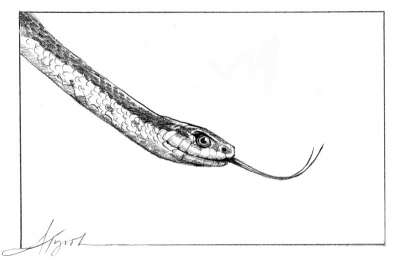
Did you ever use your hands to scoop the air toward your nose when someone takes a pie out of the oven? Snakes are doing the same thing when they flick their forked tongues.
“They are manipulating the air, bringing chemicals from the air or the ground closer so they can figure out what kind of habitat they’re in, whether there are any predators nearby, and what food items are around,” explained biologist William Ryerson. This time of year, a number of our native species may also use their tongues to track the pheromone trails of potential mates, sometimes over long distances.
Ryerson began researching snake tongues as a Ph.D. candidate, working with evolutionary biologist Kurt Schwenk at the University of Connecticut. In 1994, Schwenk published a study on why snakes have forked tongues. According to Schwenk, snakes’ tongues do not have taste receptors, and instead are used for a type of three-dimensional smelling.
The forked tongue allows snakes to sample air molecules from two different points, and this information is delivered to two separate organs in the roof of the mouth. The dual signals help snakes determine the direction that a scent is coming from. A snake may spread the tips of its tongue as it investigates a scent – as far apart as twice the width of its head. Unlike mammalian sniffing, this type of smelling is not limited to breaths; as long as the tongue is out, a snake is gathering information.
Ryerson, who has a background in physics and fluid dynamics, teamed up with Schwenk to investigate why snakes don’t simply hold their forked tongues still when they’re sampling the air.
Theories for tongue flicking have existed for centuries, Ryerson explained. “People thought it was to clean out their noses, to catch flies, or hypnotize mice — but we didn’t have a good handle on its function until recently.”
On average, snakes’ tongues can flick at a rate of three meters per second—or, six or seven flicks in a third of a second. To see the behavior in detail and observe differences between species, Ryerson used a high-speed video camera. To understand the air movement around the snakes’ tongues, he directed a laser beam through a series of lenses. These lenses took the narrow beam and converted it into a flat sheet of light. Ryerson then dispersed dust particles into the air. As they floated, they reflected the laser light. He placed a snake near the laser light (while guarding its eyes) and watched it flick its tongue. As the snake’s tongue passed through the sheet of light, the dust was disturbed, and its movement was captured by the high-speed camera.
Ryerson’s experiments showed that flicking increases the tongue’s exposure to air molecules, and therefore, its potential acuity of smell. He believes that a snake can gather information 100 times faster this way than if it simply extends its tongue downward to touch the ground.
Even among ophidiophobes (people scared of snakes) there may be reasons to appreciate snakes’ way of smelling. “If we can design a refined odor detection system with the ability to detect left and right, there are tremendous security applications,” said Ryerson.
Ryerson, who now teaches biology at Saint Anselm College in New Hampshire, continues to study snakes. He collects wild specimens, brings them into the lab for a few days, then releases them at the site of capture. Although he has plenty of practice picking snakey spots, and spends many hours tromping through the woods, he still often comes back with an empty canvas sack. His enthusiasm remains unabated. “Snakes are absolutely fascinating animals,” he said. “Even if it’s one I’ve seen a hundred times, like a garter snake, I’ll jump into the lake after it.”


Discussion *